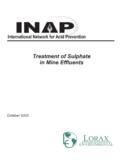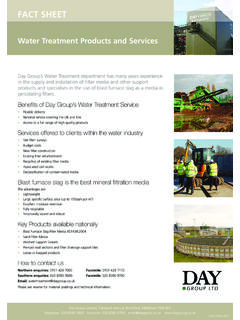Transcription of FERROUS GLYCINATE (PROCESSED WITH CITRIC ACID)
1 Chemical and Technical Assessment 61st JECFA 1 (5) FERROUS GLYCINATE ( processed with CITRIC ACID) Chemical and Technical Assessment (CTA) First draft prepared by Inge Meyland FAO 2004 1 Summary This substance has not previously been evaluated by JECFA. FERROUS GLYCINATE is an iron (II) chelate of the amino acid glycine. It is manufactured by reaction of reduced iron with glycine in presence of CITRIC acid. At chemical equilibrium over 97% of the FERROUS ions are chelated.
2 The resulting product is spray dried without previous removal of the CITRIC acid to obtain a powder. The final product contains as the only significant impurities CITRIC acid and ferric ions. The substance is highly hydroscopic and may contain water in variable amounts. The intended use of FERROUS GLYCINATE is as a nutrient both as a direct food fortificant and as a food supplement. Overall results of various studies indicate FERROUS GLYCINATE to be well suited for use as an iron fortificant and beneficial in the treatment of iron deficient anaemia at lower doses than those associated with FERROUS sulphate preparations. The stability of FERROUS GLYCINATE both what regards pH and temperature is acceptable for the intended food uses. No significant reaction with other nutrients in food has been reported.
3 The most relevant reaction of FERROUS GLYCINATE with food to take note of is the lipid peroxidation, expected to occur in response to iron oxidation in instances of disintegration of the chelate. Compared to the control unfortified foods milk and milk products fortified with FERROUS GLYCINATE did not show significant differences in lipid peroxidation. In contrast the use of FERROUS GLYCINATE for fortification of maize and maize products lowered the sensory quality and storage compared to fortification with FERROUS sulphate, FERROUS triglycinate and sodium iron EDTA, FERROUS GLYCINATE of maize. In oily bases, specifically in margarine, FERROUS GLYCINATE was demonstrated to withstand process of oxidation for extended periods of time as compared to margarine fortified with typical iron salts.
4 2 Description FERROUS GLYCINATE [(process with CITRIC acid)] is an iron (II) amino acid chelate. It contains also significant amounts of CITRIC acid resulting from the manufacturing process. The substance is highly hydroscopic and may contain water in variable amounts. Synonyms for FERROUS GLYCINATE include FERROUS bisglycinate and bis-glycino iron (II). The chemical name for FERROUS GLYCINATE is iron, bis(glycinato-N,O). The Chemical Abstract Service ( ) number is 20150-34-9. FERROUS GLYCINATE is a grey-green, free-flowing, fine powder. It is soluble in water and practically insoluble in acetone and in ethanol. FERROUS GLYCINATE has not previously been evaluated by JECFA. It is intended for use in foods and beverages as a nutrient supplement. The formulation is aimed to provide a good bioavailablity allowing for its addition to food products without significant alteration of organoleptic properties.
5 3 Manufacturing FERROUS glycine is produced by reaction of reduced iron with a mixture of glycine and CITRIC acid an aqueous solution under controlled process conditions. The resulting product is spray dried without previous Chemical and Technical Assessment FERROUS GLYCINATE 61st JECFA 2 (5) removal of the CITRIC acid to obtain a powder. (US Patent, 1989).See appendix 1 for the flow sheet of the process.
6 Raw materials Reduced iron FCC quality Glycine USP quality CITRIC acid USP quality Water Food quality Method of manufacture Reduced iron powder is reacted with a two-fold molar excess of glycine together with CITRIC acid in an aqueous environment under controlled reaction conditions. At chemical equilibrium over 97% of the FERROUS ions are chelated. The resulting product is dried to obtain a powder. All raw materials are of pharmacopoeia and/or food quality. Information from certificates of analysis for representative batches of raw materials is given in appendix 2.
7 FERROUS GLYCINATE [(process with CITRIC acid)] is manufactured under current good manufacturing practices. During the reaction the iron under neutral conditions forms a coordinate covalent complex with the ionised carboxylic acid moiety of glycine whereas under alkaline conditions, a further coordinate covalent bond is formed with the neutral amino group of glycine. Commercial formulations contain in addition silicon dioxide ( ), maltodextrin (2%). These formulations were used in studies for stability and bioavailability. Since FERROUS GLYCINATE is produced from reactions in an aqueous environment with subsequent drying to a powder, slight variations in product colour and particle size may be anticipated. Each manufactured lot is tested by infrared absorption measurements to control that chelation is obtained.
8 A characteristic IR-spectrum of FERROUS GLYCINATE with a spectrum for glycine as comparison is shown in appendix 3. 4 Chemical characterization In FERROUS GLYCINATE chemically, the carboxyl group and the -amino group of glycine both donate electron pairs into the FERROUS iron cation forming coordinate covalent bonds (McMurry & Fay, 1995; Atkins & Beran, 1992). Iron serves as the closing member in the formation of the two resulting 5-membered heterocyclic rings. The chemical formula of anhydrous FERROUS GLYCINATE is Fe(COOCH2NH2)2, and its molecular weight is The chemical structure is shown below. OOC C H2NH 2ON H 2F eOCCH 2 FERROUS GLYCINATE [(process with CITRIC acid)] consists predominantly of FERROUS GLYCINATE , CITRIC acid and water. The only impurity present in significant is ferric ions.
9 Contents of lead in the final products are low. On the basis of the manufacturing process including raw materials there is no need for criteria for other inorganic impurities in the specifications. See appendix 4 for composition of final products. 5 Functional uses In the studies referred to below FERROUS GLYCINATE has been administered as the commercial formulation of FERROUS GLYCINATE [(process with CITRIC acid)] containing maltodextrin and silicon oxide. FERROUS GLYCINATE may be used as a direct food fortificant or as a food supplement. As a food supplement, it may be formulated into tablets, capsules, solutions or suspensions, or alternatively appear as an ingredient Chemical and Technical Assessment FERROUS GLYCINATE 61st JECFA 3 (5) of other products used for purposes of dietary supplementation.
10 Currently, commercially available foods fortified with FERROUS GLYCINATE include milk, fruit juices and fruit flavoured powdered drinks, yoghurt, soft cheese products, cookies, bread, granola and snack bars, all of which are primarily restricted to Latin America with the exception of milk and yoghurt, which also are available to consumers in Italy and Spain. Properties of stability and high bioavailability characterize FERROUS GLYCINATE make it suitable as an iron supplement option for use in feeding intervention programs, particularly those involving the fortification of milk with iron. As discussed by Name (1996), primary attributes of FERROUS GLYCINATE , with respect to its use as an iron milk fortificant, include no alteration of milk s properties, such as taste and colour, and a lack of oxidative process involving components of the milk upon the addition of FERROUS GLYCINATE .
















